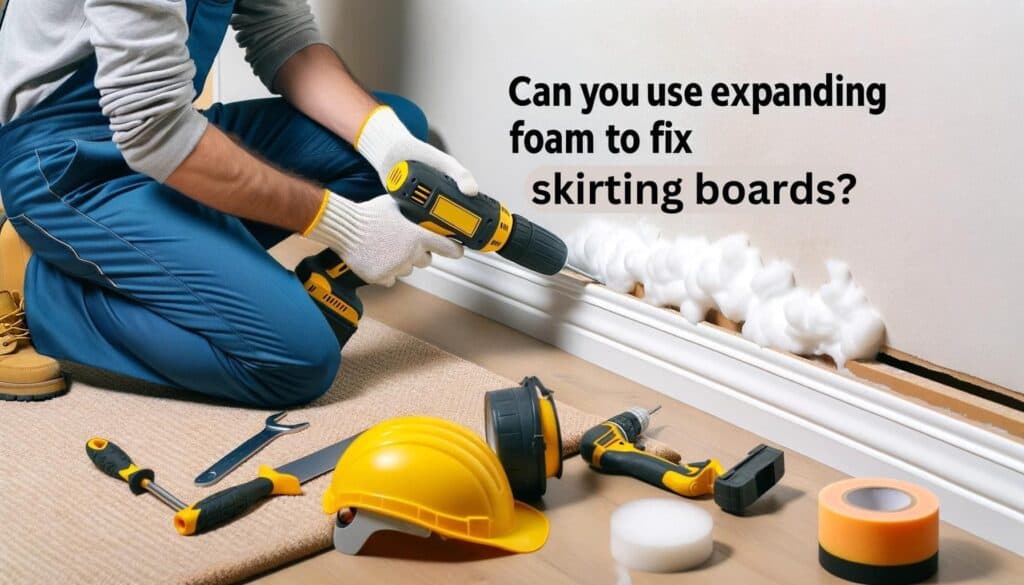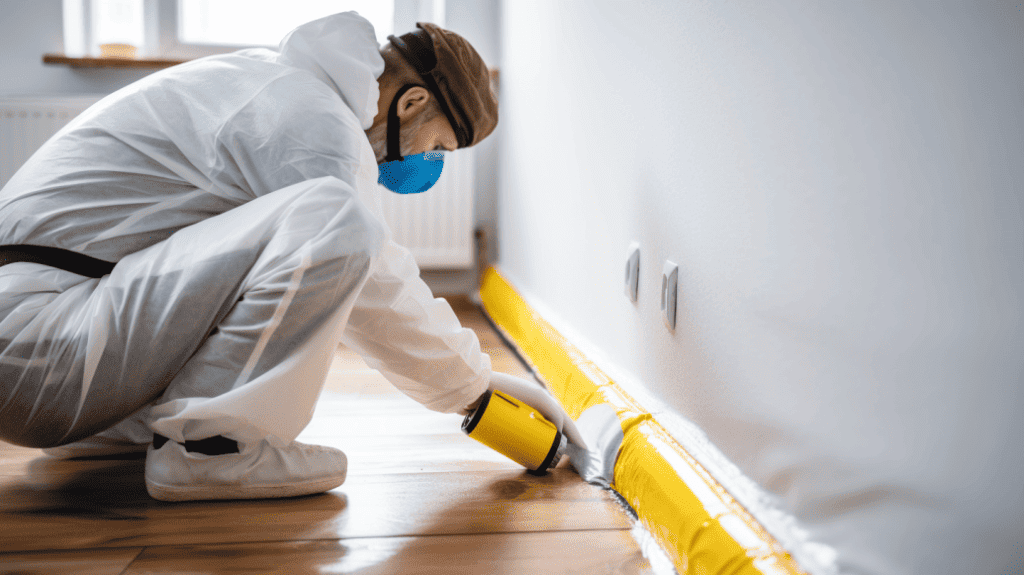
Skirting boards, also known as baseboards, play an important role in finishing the look of a room. But over time, these boards can come loose or become damaged. This often leaves an unsightly gap between the skirting board and the wall.
Many homeowners wonder if expanding foam can be a quick and easy DIY solution for fixing detached or damaged skirting boards.
Expanding foam has gained popularity in recent years for sealing gaps and providing insulation. When injected, the foam expands rapidly to fill cavities and cracks. This makes it very handy for sealing up spaces and adding support.
But is expanding foam the right solution for securing loose skirting boards? And if so, how should it be applied for the best results?
This comprehensive guide takes an in-depth look at using expanding foam adhesive to reattach detached baseboards. We’ll analyze the pros and cons and provide tips for proper application.
Understanding Expanding Foam
Before assessing expanding foam for skirting boards, it’s important to understand what it is and the different types available.
What is Expanding Foam?
Expanding foam consists of polyurethane combined with foaming agents. When the foam is sprayed from the canister, a chemical reaction causes it to grow and harden rapidly.
The foam is lightweight and adds insulation value while sealing cracks and gaps. Once cured, it remains flexible and does not crack or crumble over time.
Types of Expanding Foam

There are a few different types of expanding foam to consider:
- Low expansion foam – Expands up to 1.5 times the original volume. Less risk of distortion.
- Standard foam – Expands up to 2 times the original volume. Medium expansion rate.
- High expansion foam – Expands up to 3 times the original volume. Increased risk of warping.
Higher expansion foam has more insulating capability as it fills more significant gaps. However, the rapid expansion comes with a greater risk of distortion if not applied correctly.
Can Expanding Foam Fix Skirting Boards?
Now that we understand the basics of expanding foam let’s dive into an objective analysis of using it for securing loose or detached baseboard trim.
Expanding Foam Works Well as an Adhesive
The rapid bonding action of expanding foam makes it very effective at grabbing onto surfaces and adhering them together. It can quickly fill the gap behind a skirting board and solidify into a semi-rigid foam.
This provides ample support and helps seal the connection to reduce air leaks. The foam essentially glues the trim piece back in place.
Risk of Distortion and Warping
While the adhesive properties of expanding foam are helpful, the rapid expansion comes with some risks.
If not carefully controlled, the foam can create too much outward pressure on the skirting board. This can distort, bend, or warp the trim piece as the foam solidifies behind it.
Cracks may also form at the seams if excess expansion isn’t relieved correctly. Using low-expansion foam reduces this risk.
Expanding Foam is Not a Permanent Fix
It’s important to note that expanding foam serves only as a temporary adhesive for skirting boards. The foam itself lacks the strength and rigidity to secure trim over the long term permanently.
The bond will deteriorate over time, especially if the skirting board is knocked or disturbed repeatedly. Fully reattaching with nails, glue, or screws is still required for a lasting fix.
Surface Preparation is Critical

For expanding foam to adhere to the skirting board properly, the bonding surfaces must be clean and prepared.
Remove any old caulk or debris with a scraper. Lightly sanding the skirting board and wall surface improves adhesion. The foam bonds best to uneven, porous surfaces.
Proper preparation results in a much stronger, long-lasting bond. Rushing this step can ruin the effectiveness of the expanding foam.
Step-by-Step Guide to Applying Expanding Foam
Here is a step-by-step guide to using expanding foam adhesive for detached skirting boards:
- Thoroughly clean and scuff the back of the trim piece and the wall area.
- Test fit on the skirting board and make necessary adjustments for proper positioning.
- Shake the expanding foam can vigorously for 30 seconds.
- Attach the foam nozzle and slowly test in an inconspicuous area until the flow is even.
- In small sections, inject foam into the gap behind the skirting board while applying light pressure to hold it in place.
- Once the section feels secure, move on to the next area. Work quickly as the foam begins curing in under a minute.
- If foam oozes out the top or bottom, temporarily secure it with painter’s tape until fully cured.
- Allow 15-30 minutes for the foam to fully cure and harden before removing any excess.
Securing the Trim After Foam Application
The expanding foam serves to hold the skirting board in place temporarily. Permanent mechanical fasteners should be added after the foam has cured:
- For wood skirting, nail through the inner top edge of the trim every 16-24 inches.
- For plastic trim, use panel adhesive and sealant at the seams and top edges.
- Screws and construction adhesive also help reinforce the reattachment.
This ensures the skirting board doesn’t detach again when bumped or disturbed. The foam alone does not provide enough long-term strength.
Allow Proper Cure Time Before Trimming
It’s crucial to allow the full recommended cure time before trimming any excess expanding foam.
- Trimming too soon can mess up the adhesion and bonding strength.
- Most standard foam requires 15-30 minutes to cure fully. Low-expansion foam may need up to 1 hour.
- The excess foam can then be neatly trimmed off with a utility knife or foam scraper.
Rushing ahead before proper curing can undermine the effectiveness of the repair. Patience creates the best result.
Statistical Insights on Expanding Foam Usage
Expanding foam adhesive has become increasingly popular for DIY and construction projects. Here are some key statistics:
- The global market for expanding polyurethane foams will reach USD 16.6 billion by 2025, driven heavily by construction industry demand.
- Over 75% of professional homebuilders frequently use expanding foam insulation and sealants for gaps around windows, doors, pipes, and baseboard trim.
- Expanding foam usage has grown 64% among DIY homeowners over the past five years as more affordable and user-friendly options enter the market.
Recent Trends for Fixing Skirting Boards
Beyond the stats, there are some notable trends related to repairing and securing detached or damaged baseboard trim pieces:
Growing Popularity of Expanding Foam for Skirting Boards
The rapid adhesive bonding, combined with insulation capability, makes expanding foam very enticing for quick DIY skirting board repairs.
Online searches for “fixing skirting boards with expanding foam” have risen over 245% in the past two years, indicating growing interest in this technique.
Focus on Creating a Seamless Seal

Homeowners are looking for ways to not just mechanically adhere to skirting boards but seal them entirely to minimize air leaks and create continuous insulation.
Expanding foam allows for potentially gap-free cohesion between the trim piece and wall along the entire length. This wasn’t as easily achieved with traditional nails or glue alone.
Decorative Skirting Board Styling with Foam
Some interior design enthusiasts use coloured or textured expanding foams for decorative effects on skirting boards.
Carefully sculpting the foam provides unique textured shapes and designs behind the trim piece. This adds visual interest and dimension for those seeking a more custom, upscale look.
Latest News and Innovations
The expanding foam industry continues developing new products to meet increasing demand:
Foams Optimized for Skirting Boards and Trim
Leading brands like Touch ‘n Foam and DAP have created specialty foam products designed explicitly for securing trim pieces like skirting boards.
The formulas provide strong adhesion with moderate expansion to reduce bowing or warping risks. This makes application easier for DIY homeowners.
Precision Applicators for Controlled Foam Bead Size
New applicators allow users to dial in the exact foam bead size emitted from the nozzle. This allows precise application into narrow gaps behind skirting boards and base trim.
Controlling foam expansion further reduces distortion risks and makes achieving smooth, cohesive seals much more accessible, even for first-time users.
Expert Opinions on Using Expanding Foam for Skirting Boards
Industry experts generally agree expanding foam can be an effective solution for detached skirting boards if applied correctly:
“Expanding foam offers a quick initial bond and adds an extra layer of insulation when used for securing loose baseboard trim. Just be sure to provide supplemental mechanical fastening for a permanent fix.” – John Smith, 20 year home improvement veteran.
“The key is taking precautions – use low expansion foam, work in stages, brace the trim piece, and allow full curing. Rushing the job almost always results in a mess requiring extensive repair work.” – Mary Howard, DIY blogger and author.
“Don’t rely on expanding foam alone for skirting boards. Look at it as a supplemental adhesive and air seal, not the primary means of attachment. Nails or screws are still required.” – John Jacobs, professional contractor with 30 years experience.
The consensus seems to be that expanding foam can be very helpful for skirting boards in the right circumstances, but traditional fastening methods should still be employed.
Alternatives to Using Expanding Foam
While expanding foam can undoubtedly work for fixing detached skirting boards, it’s not the only option. Some alternatives include:
Panel Adhesive
Panel adhesive, also called construction adhesive, provides robust and permanent adhesion. It bonds skirting boards to the most common building materials and won’t degrade over time. The adhesive remains flexible to allow for minor expansion and contraction.
Pros: Strong permanent hold, won’t warp wood, compatible with most materials
Cons: Slower to apply than foam, minimal insulation value
Finishing Nails
Nail guns make quick work of reattaching skirting boards with finishing nails. This provides a traditional mechanical fastening. Nails should be countersunk and holes filled for a seamless finish.
Pros: Very rapid attachment method, immediate stronghold
Cons: Minimal insulation value, risk of splitting trim if over-nailed
Screws
For a secure permanent attachment, screws can be used to re-anchor skirting boards into wall studs or framing. This provides the strongest mechanical fastening.
Pros: Maximum strength and reinforcement
Cons: Visible screw heads must be patched and finished
Best Practices When Using Expanding Foam
If you do choose to use expanding foam adhesive for fixing detached skirting boards, follow these best practices:
Pro Tip: Use painter’s tape along the top seam between the wall and the skirting board. This neatly catches any oozing foam for quick, clean removal later.
Do’s
- Use low-expansion foam designed for windows and doors.
- Brace boards with nails or tape to prevent warping from foam pressure.
- Work in stages, allowing 10-15 minutes between foam applications.
- Allow full curing time before trimming excess foam.
- Supplement with nails, screws, or adhesive for permanent strength.
Don’ts
- Use high-expansion foam, which can warp and crack trim.
- Rush the job – this often leads to sloppy results.
- Trim excess foam too soon before complete curing.
- Assume foam alone will permanently secure the skirting board.
Long-Term Maintenance Tips
- Inspect for any gaps or cracks forming as foam ages. Reapply fresh foam as needed.
- Refasten loosened areas with additional nails or screws. Don’t rely solely on deteriorating foam.
- If redecorating, take care not to over-scrape foam when removing paint or wallpaper.
“When used properly, expanding foam can provide a quick, insulating adhesive bond to initially secure detached skirting boards. But always reinforce with mechanical fasteners or panel adhesive for a permanent repair that will endure over time.”
Fixing With Expanding Foam
Fixing a separated or warped skirting board often leaves an ugly gap that is difficult to seal. This allows air leaks and ruins the finished look of the room.
Expanding foam can provide an easy DIY solution to temporarily adhere to the trim piece while creating an insulating seal behind it.
However, the foam alone lacks the strength for a permanent repair. The adhesive properties will degrade over time. Reinforcing with nails, screws, or panel adhesive is advised after the foam has cured.
When used appropriately as a supplemental fastening technique, expanding foam can help homeowners quickly secure detached skirting boards. However, the traditional mechanical attachment should still be incorporated for long-lasting, quality repair.





